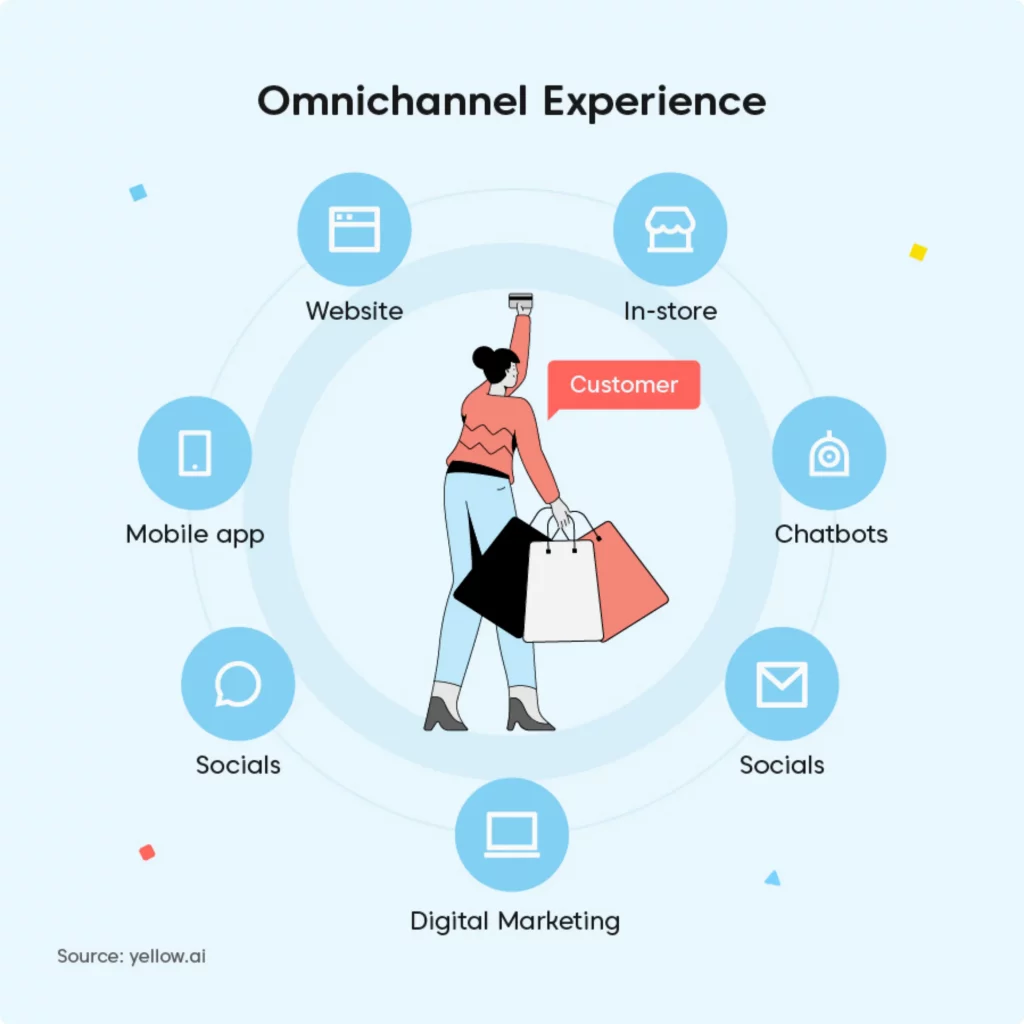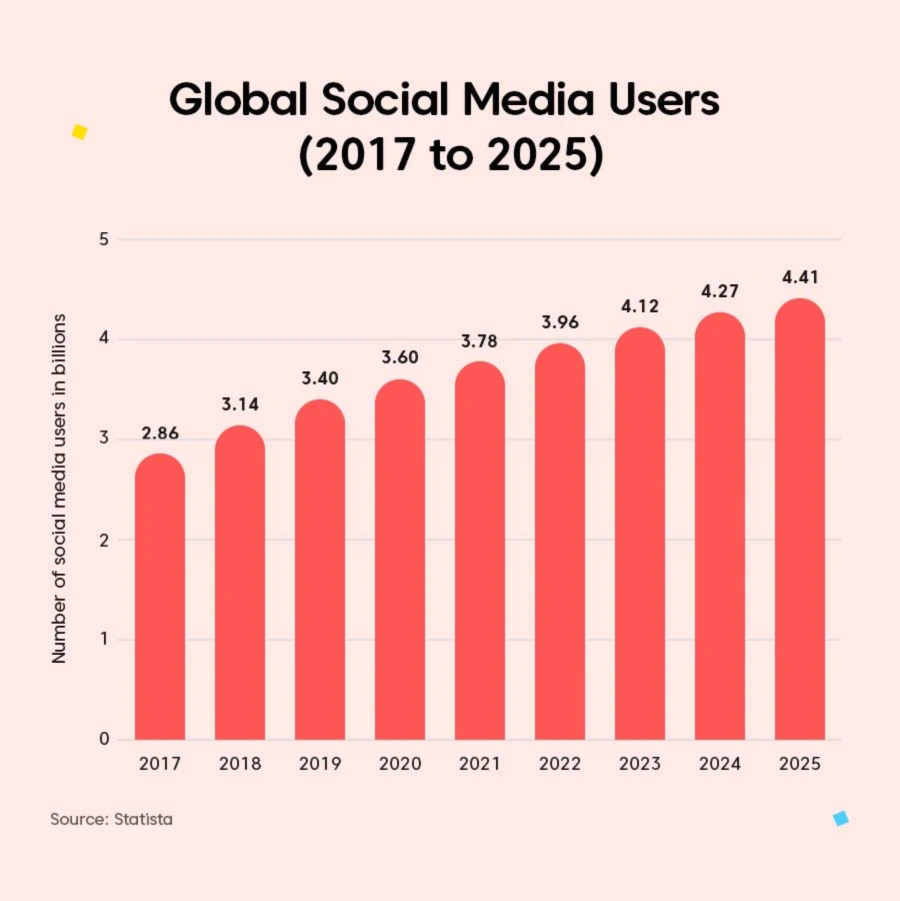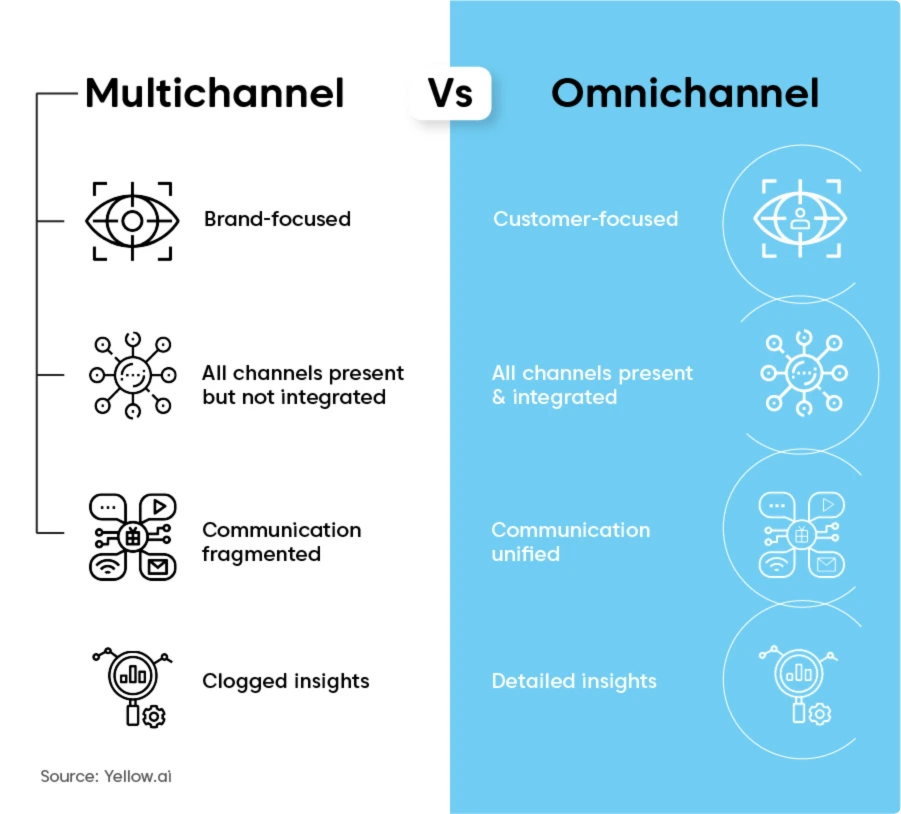The importance of digital communication channels for businesses has certainly risen, with an obvious acknowledgement that to deliver a superior customer experience, one has to look beyond the conventional medium of voice or emails. Online spending worldwide has been on the rise for the past few years. According to a study conducted by Digital Commerce 360, there is a likelihood of a substantial jump in the fraction of sales through e-commerce platforms in the coming years and it has become essential for businesses to offer an omnichannel experience to keep pace with the shift.
All businesses must get accustomed to a world where customers wish to purchase, share thoughts, find information, and ask for help on multiple channels: online, mobile, chatbox, through call centers, and in brick-and-mortar stores.
What is omnichannel?
Omnichannel emphasizes on delivering a unified customer experience irrespective of the platform used. It fulfills customers’ demands at all touchpoints and offers the same experience and functionality across channels, regardless of how a consumer wants to interact. With omnichannel experience, businesses get to help customers at all stages of their journey- discovery, research, purchase, support, and customer service and help build an enduring relationship.
In other words, omnichannel experience is a cross channel approach that allows customers to reach your brand through several integrated communication channels, irrespective of where they are and offer exceptional service at all key touchpoints including email, social media, messenger platforms, websites, etc.

How does omnichannel work?
Despite having several moving parts, omnichannel works as a single, organized system. Each touchpoint offers a unique but connected experience that builds on preceding exchanges and leads the customer on the journey to a preferred outcome. Omnichannel allows a company to gather and combine customer data from several channels. The combined data offers a complete illustration of the categories of customers interested in a brand and their actions, which gives the brand the ability to personalize the customer journey.
Only by comprehending the customer journey can a brand personalize customers’ experience. Omnichannel permits brands to establish a personalized experience. Establishing a personalized experience is key to omnichannel customers as they have a higher lifetime value over customers who purchase using only a single channel.
An omnichannel approach across producers and dedicated retail partners makes the whole journey smooth without forcing customers to input the same data, carry out the same tasks and ask the same questions across different channels.
Omnichannel experience trends 2022
In the rapidly transforming economy today, it’s absolutely essential to stay updated on the modern trends shaping the world of omnichannel. Here’s a list of some of the most popular developments in the omnichannel space:
1.The pandemic has given a boost to omnichannel shopping habits
The Covid-19 pandemic pushed countless businesses to switch to omnichannel over a period of a few months, unlike the multi-year rollouts they perhaps would have planned.
2. Brick-and-mortar continues to be a key component of omnichannel ecosystem
The pandemic hasn’t nullified the importance of the brick-and-mortar stores, in fact, they have emerged as a key part of the overall omnichannel ecosystem. While the idea of physical retail spaces may have changed, they remain an essential element of the buyer’s journey.
3. The popularity of digital payments continues to rise
The use of digital payment options such as mobile wallets, P2P payment platforms, real-time payments, other cashless alternatives, and even cryptocurrencies will continue to skyrocket.
4. More and more people use social media for interacting with brands
In the past ten years, social media has played an instrumental role for brands to expand their audiences, amass glowing reviews, deliver advanced customer support, and push traffic to their revenue-generating sites. Today, several social media platforms are taking retailer profiles to the next level by offering built-in shopping features.

Omnichannel vs multichannel
Through an omnichannel experience, customers are able to connect to a brand seamlessly across various platforms such as websites, mobile apps, physical stores. It allows them to interact with a brand and address their concerns over the phone, webchat, social media, and email among others.
Omnichannel allows businesses to drive past the functional strategies of multichannel into a model that unites two or more channels and shares data between them. This enables customers to interact with a brand over multiple platforms without any loss of information.
For instance, if a customer who has initiated a chat with a business on webchat offers a little information, and then chooses to end the chat and call an agent instead, all the information shared on chat can be conveyed to the agent through an omnichannel solution. A business with multichannel capacities can assist the customer on both channels, but since it doesn’t have back-end systems integration, the customer will have to enter all the details once again. On the other hand, with omnichannel experience, all channels are seamlessly connected. This implies that a customer need not enter or state the details mentioned earlier again and again and instead enjoys a unified experience across all platforms. There is much more to how omnichannel streamlines customers’ experiences across channels.
1. No loss of information
Omnichannel offers a unified experience that doesn’t depend on the channel chosen while multichannel offers separate experiences across channels.
2. Better personalization
Customers will enjoy personalized service supported by contextual data with omnichannel while there is a lack of insights to provide a personalized experience on multichannel.
3. Shorter sales cycle
Sales cycles are shortened and costs are reduced with omnichannel, on the other hand, it takes longer to close sales in multichannel leading to increased expenditure.
4. Streamlined cross-channel interactions
There is smooth cross channel communication with omnichannel while customers often struggle to shift from one channel to another in multichannel.

Why is an omnichannel customer experience important?
With omnichannel experience, the various available channels are parallel as well as synchronized to each other. Businesses can manage customer journeys more efficiently by upselling goods and services, customizing marketing content, and proactively overcoming barriers. Some key benefits that omnichannel experience offers to both businesses and customers are:
How can you develop an omnichannel approach?
As discussed above, omnichannel focus on delivering unified customer experiences on every single platform. There is a need for the free movement of data between business communication and marketing channels. In order to develop an omnichannel approach to customer experience, businesses need to strategize and develop an omnichannel approach.
Although every business has a different approach, there are a few basic building blocks of an omnichannel approach. These building blocks can lay a foundation and create an uptight back-end so that there are no silos in customer experience and insights. Below are a few points that will help you move towards an omnichannel approach.
1. Identify and tear silos
The first step toward an omnichannel approach is to identify and break down silos. If in your organization, all departments work separately and are self-contained, all the information regarding various ongoing activities and budgets becomes opaque to everyone apart from the leaders. This needs to be changed in order to have an omnichannel mindset.
Various departments such as product development, UX experts, designers, data specialists and customer experience can work together and break down silos.
2. Design for users
For an omnichannel approach, it is important to focus on how easily customers are able to shift from one platform to another while communicating with your business. In order to keep the transition smooth, all marketing channels need to be developed and optimized around providing a seamless connection between the customer and the business.
UX specialists play a crucial role in observing and reporting any friction or disconnect for the users when they move between channels and back again.
3. Create an integrated system
Centralizing data and building one integrated system is essential while setting up an omnichannel experience for your users. A powerful CRM or CEM needs to be set up that is visible from all parts of the business and contains meaningful data and insights about all the marketing channels.
Having a CRM in place also helps businesses collect and manage feedback from various sources in various formats. It can sort the customer feedback of all formats be it numbers, random text in natural language, series of strings or multiple-choice questions.
An omnichannel approach can be very useful for businesses as they can get all information under a single integrated system and make informed decisions.
4. Standardize measurements
In order to provide a unified experience, businesses need to unify all the measurements and find a way to quantify every metric. Only then can businesses find the areas that need attention and functions that are already out-performing.
An omnichannel platform can help businesses collect and organize the metrics to derive some useful insights. It can interpret qualitative and experiential data, convert it into actionable information and help businesses in improving experiences.
5. Take a journey-level approach
Working based on targets is good but taking into account the customer’s point of view is eventually the final resort to provide a good customer experience. Businesses need to take a journey-level approach while selling their products and services and group together all the elements that build a single customer’s journey.
Omnichannel Marketing Examples
Now that we have seen the concept of omnichannel customer experience and understood all about it theoretically, let us look at some practical examples of organizations that implemented a complete omnichannel strategy.
1. Starbucks
Starbucks provides one of the most efficient omnichannel experiences through its Starbucks rewards program.
Customers can avail their loyalty points and rewards anytime they place an order at Starbucks. Not just this, users can check and avail of the rewards from any platform including phone, mobile application, website or in-store. The rewards card is updated in real-time across all channels breaking the silos and delivering a wonderful experience.
The brand is successful because it meets the customer at the right time in the right place, that is, it delivers an excellent customer experience through the mobile application and updates the data in real-time.
2. Sephora
Sephora is a beauty and cosmetic products giant that has set a brilliant example of an omnichannel retail experience for other brands. It allows customers to unify their in-store and online experiences using a “Beauty Bag”. Customers can try on and add products to their beauty bag using the in-store tablets and order at home.
Sephora also allows customers to try on different cosmetic products using the mobile application and website. This feature has helped customers buy the right makeup products online.
3. Amazon
Amazon has mastered the art of omnichannel experience in the retail space. It works so smoothly on the customer data and provides personalized recommendations, serves relevant promotions and allows customers to buy products quickly and easily.
A customer on Amazon can access their profile from anywhere in the world and use their subscriptions without any hassle.
Even for customer service, Amazon knows how to clearly satisfy their customers and resolve queries on a platform of their choice. Whenever a customer reaches out to Amazon with any product or service-related issue, they are given options to either receive a call or an email. Customers can select their choice and expect a call or email within the next 2 minutes.
4. Pepperfry
Pepperfry has smoothly intertwined the online customer experience and in-store experience using Pepperfry studio. It allows customers to select furniture online and visit the studio to check it out.
The furniture store also provides a design consultant at the studio to help customers select the best piece of furniture that fits their requirements and meets their budget. Once the customer has selected their piece of furniture, they can either buy it from the studio or order online.
This intertwined experience is loved by customers and has led to 10-15% of sales through the studio locations.
5. Apple
Apple has created an ecosystem where customers can interconnect all their apple products with each other. For example, an iWatch can be connected to an iPhone that can be further connected to the Mac OS.
A customer needs to create an iCloud account the first time they purchase an Apple product. After that, all the data is retrieved from the cloud whenever the same identity is used to login into any other Apple product. Messages, images and all personal data are visible to the customers no matter which device they use to access the data.
How to improve the omnichannel customer experience
Even a successful omnichannel strategy has a scope for improvement and development. Businesses should expect wonders from a frail and overused strategy and need to work continuously towards being better. Below are some ways to go about it and improve the omnichannel customer experience.
1. Understanding customer expectations
Consumer behavior keeps on changing time-to-time. Businesses need to maintain a robust and flexible omnichannel strategy so as to adjust as per customer expectations.
Businesses can use big data and analytics to keep a keen eye on the changes in consumer behavior. They can make use of business intelligence and analytics software in the research process and make sure that they do not waste their resources on faded strategies.
2. Following the leaders
Omnichannel space is highly dependent on the customers. Leaders in the industry continuously assess and analyze customers’ reactions to new strategies and communication channels. Following the leaders can give businesses an upper hand over their competitors and open new gates to customer interaction.
3. Developing mobile capabilities
Having a mobile-friendly commercial and communication platform is one of the most basic necessities a customer looks for in a business. Brands must ensure a smooth and consistent experience for customers reaching out from their mobile devices. This will not only help them improve their customer experience but also their rankings on search engine result pages.
4. Conducting a content analysis
Content is a big part of business interaction. It includes all the articles, social media posts, podcasts, videos, emails and messages a brand uses to reach out to its potential and existing customers. It is very important that businesses maintain consistency and clarity in each and every content piece. Analyzing and altering content from time to time is an excellent way to maintain a clear and crisp brand identity, no matter where your customers find you.
5. Improving response time or TAT
A quick response is one of the traits of great customer service, and eventually, it leads to higher customer satisfaction and improved customer loyalty. For businesses without automation, it is quite difficult to reach the benchmark and respond to customers timely on each and every channel.
With an omnichannel approach and automation using chatbots, businesses can ensure quick responses and improve customer experience without any hassle.
6. Unifying online and offline approach
However, most of the interactions are done online through digital channels, there are a number of offline channels that brands can target to reach out to potential customers. The most important part is to offer a unified and consistent brand experience through both online and offline channels.
While improving the omnichannel customer experience, businesses can focus on consistency on offline channels such as magazine ads, event sponsorships and branded merchandise.
7. Choosing (or eliminating) channels wisely
Omnichannel experience does not mean that a brand needs to be present on every channel. Businesses need to observe the channels that have maximum traction and are the most used by their customers.
Brands should not waste their resources on channels where the message is not heard, instead, they can improve marketing on the channels where customers are present.
Future of omnichannel
The future of omnichannel will revolve around connected experiences, personalization, efficiency, and convenience. Shoppers today are well-informed of the choices available to them. If you don’t deliver experiences that are aligned with their expectations, they’ll be quick to switch to a competitor. This is why businesses must offer such experiences to the customers that are more convenient and fulfill their changing needs.
Before jumping in, guns ablaze, transforming your entire strategy to omnichannel, it’s important to take a step back. The focus should not only be on offering more channels but also, integrating them into a single-seamless experience. Let’s look at how Yellow.ai can help you empower your agents to offer omnichannel support to your customers.
Delivering an omnichannel experience with Yellow.ai
Yellow.ai’s INBOX, which is an integrated omnichannel customer support help desk, helps agents respond to customer queries across more than 35 conversational networks. With a perceptive UX, INBOX enables agents to manage requests from a single dashboard in any language, offering extensive customer history with exceptional context, thereby lowering query resolution time.
Easy to integrate with top CRM systems, INBOX simplifies assisting customers on different communication channels – email, voice, website, social media, and app by showing all the queries in a single contextual view, transforming customer support into a more efficient and logical process.
How has Yellow.ai helped businesses implement robust omnichannel experiences?
Yellow.ai’s B2B omnichannel customer support helpdesk manages customer queries on numerous conversational modes. Here are two instances of how Yellow.ai’s omnichannel solution has delivered an exceptional experience for the customers:
Frequently Asked Questions
Omnichannel involves using more than one channel to increase sales by concentrating on providing a unified customer experience regardless of the client’s location. E-commerce meanwhile is the trading of goods and services, or the transmission of data or funds, across an /electronic network.
Omnichannel in retail illustrates a retailer’s attempts to deliver a steadfast, coordinated customer experience across all customer channels through reliable, universal data.
Omnichannel in banking means that users can carry out all the banking tasks from a mobile app, website, a call center, the bank’s branch, or any other relevant channel.
Cross-channel is the next level up from multi-channel while omnichannel takes the concept of omnipresence into account with customers having the ability to use various channels at the same time.


















